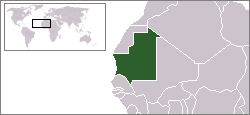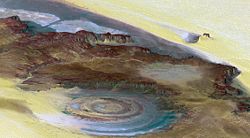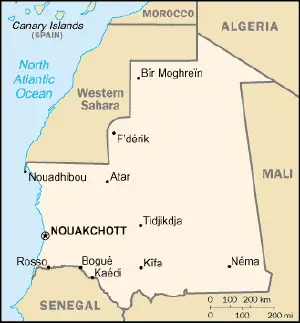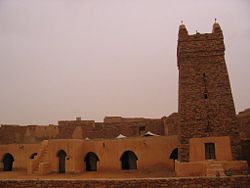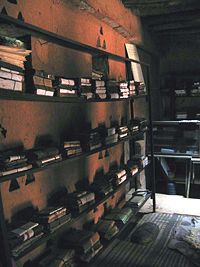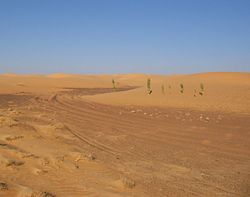Mauritania
| اÙجÙ
ÙÙرÙØ© اÙإسÙاÙ
ÙØ© اÙÙ
ÙرÙتاÙÙØ© al-ǦumhÅ«riyyah al-ʾIslÄmiyyah al-MÅ«rÄ«tÄniyyah République Islamique de Mauritanie Republik bu Lislaamu bu Gà nnaar Islamic Republic of Mauritania |
||||||
|---|---|---|---|---|---|---|
|
||||||
| Motto: شر٠إخاء عد٠ (Arabic) "Honor, Fraternity, Justice" |
||||||
| Anthem:Â "National Anthem of Mauritania" |
||||||
| Capital (and largest city) | Nouakchott 18°09â²N 15°58â²W | |||||
| Official languages | Arabic1 | |||||
| Demonym | Mauritanian | |||||
| Government | Islamic republic2 | |||||
| Â -Â | President | Mohamed Ould Ghazouani | ||||
| Â -Â | Prime Minister | Ismail Ould Bedde Ould Cheikh Sidiya | ||||
| Independence | ||||||
| Â -Â | from France | 28 November 1960Â | ||||
| Area | ||||||
|  - | Total | 1,030,700 km² (29th) 397,954 sq mi |
||||
|  - | Water (%) | 0.03 | ||||
| Population | ||||||
| Â -Â | 2019Â estimate | 4,556,758[1]Â | ||||
| Â -Â | 2013Â census | 3,537,368Â | ||||
|  - | Density | 3.4/km² 8.8/sq mi |
||||
| GDPÂ (PPP) | 2018Â estimate | |||||
| Â -Â | Total | $18.117Â billion[2]Â (134th) | ||||
| Â -Â | Per capita | $4,563[2]Â (140th) | ||||
| GDP (nominal) | 2018Â estimate | |||||
| Â -Â | Total | $5.200Â billion[2]Â (154th) | ||||
| Â -Â | Per capita | $1,309[2]Â (149th) | ||||
| Gini (2014) | 32.6[3] | |||||
| Currency | Ouguiya (MRO) |
|||||
| Time zone | (UTC+0) | |||||
|  - | Summer (DST) | not observed (UTC+0) | ||||
| Internet TLD | .mr | |||||
| Calling code | +222 | |||||
| 1According to article 6 of Constitution: The national languages are Arabic, Pulaar, Soninke, and Wolof; the official language is Arabic. French is de facto co-official. 2Not recognized internationally. Deposed leaders President Sidi Ould Cheikh Abdallahi and Prime Minister Yahya Ould Ahmed El Waghef no longer have power as they were arrested by military forces. |
||||||
The Islamic Republic of Mauritania, or Mauritania, is a country in northwest Africa. The coast faces the Atlantic Ocean on the west, and Senegal lies to the southwest, Mali to the east and southeast, Algeria to the northeast, and the Moroccan-annexed territory of Western Sahara to the northwest. The country's capital and largest city is Nouakchott, located on the Atlantic coast. The country is named after the ancient Berber kingdom of Mauretania.
Mauritania is a land dominated by sand and barren soil located on the western flank of the Sahara Desert. Mauritania sees itself as a link connecting the northern, Arab nations of North Africa's Maghreb and the sub-Saharan Black African countries that make up the rest of the continent.
A long history of being one of the world's poorest countries has the potential to change as Mauritania has recently discovered large offshore reserves of oil and natural gas. The goal of economic independence is now a feasible possibility. The main obstacle to this economic independence is the political and ethnic disunity that has plagued the country for centuries.
Geography
Mauritania is generally flat, its territory of over one million square kilometers (618,000 square miles) forming vast, arid plains broken by occasional ridges and cliff-like outcroppings. A series of scarps face southwest, longitudinally bisecting these plains in the center of the country. The scarps also separate a series of sandstone plateaus, the highest of which is the Adrar Plateau, reaching an elevation of 500 meters (1,640 feet). Spring-fed oases lie at the foot of some of the scarps. Isolated peaks, often rich in minerals, rise above the plateaus; the smaller peaks are called guelbs and the larger ones kedias. The concentric Guelb er Richat (also known as the Richat Structure and the "Eye of the Sahara") is a prominent circular feature in the Sahara desert of westâcentral Mauritania is a prominent feature of the north-central region. Kediet Ijill, near the city of Zouîrât, has an elevation of 1,000 meters (3,280 feet) and is the highest peak.
Richat Structure, located in the Sahara Desert of Mauritania, at Gres de Chinguetti Plateau, has been a focus of world attention due to its bull's eye shape. The structure is 30 miles (50 kilometers) in diameter and has become a landmark for crews of the space shuttle. Once thought to be a meteorite impact structure, it is now considered to be a symmetrical uplift (circular anticline) laid bare by erosion.
Though the interior contains mineral resources, the country's best-known exports may be the weather disturbances that form in the summer and fall, move offshore into warm ocean water, form cyclonic winds, head west for the Americas as tropical storms with assigned names, develop into hurricanes, and occasionally devastate islands and cities.
History
From the third to seventh centuries C.E., the migration of Berber tribes from North Africa displaced the Bafours, the original inhabitants of present-day Mauritania and the ancestors of the Soninke. The Bafours were primarily agriculturalist, among the first Saharan people to abandon their historically nomadic lifestyle. With the gradual desiccation of the Sahara, they headed south. Following them came a migration of not only central Saharans into West Africa, but Berbers and Arabs as well.
By the eleventh century, the once small Bafour people had grown into a very large and wealthy Soninke empire, later called the Ghana Empire, which stretched from Mauritania into the neighboring states of Senegal and Mali. Likewise, in the north, the Arab-Berber population had achieved an impressive empire of its own, the territory of which stretched across the Mediterranean into Spain and Portugal. Local nomadic Berber tribes, though influential, remained largely without power, having been conquered by the Soninke.
In 1076 Islamic warrior monks (Almoravid, or Al Murabitun) attacked and conquered the ancient Ghana Empire. Over the next 500 years, Arabs overcame fierce resistance from the local population (Berber and non-Berber alike) and came to dominate Mauritania. The Mauritanian Thirty-Year War (1644-1674) was the unsuccessful final effort to repel the Yemeni Maqil Arab invaders led by the Beni Hassan tribe. The descendants of the Yemeni Beni Hassan warriors became the upper stratum of Moorish society. Berbers retained influence by producing the majority of the region's Maraboutsâthose who preserve and teach Islamic tradition. Many of the Berber tribes claimed to be of Yemeni (and sometimes other Arab) origin. There is little evidence to suggest this, though some studies do make a connection between the two. Hassaniya, a mainly oral, Berber-influenced Arabic dialect that derives its name from the Yemeni Beni Hassan tribe, became the dominant language among the largely nomadic population.
Aristocrat and servant castes developed, yielding Beidane or "white" Moors (the aristocracy), kewri (the indigenous peoples who were never enslaved), and Haratin or "black" Moors (the formerly enslaved). The Haratin, who are Muslim and speak Arabic, are mainly the former slaves of the Beidane, though some families were never enslaved. The Haratin have always been a disadvantaged group because of their slave status and are generally looked down on by both the Beidane and the sub-Saharan African population.
French colonization at the beginning of the twentieth century brought legal prohibitions against slavery and an end to interclan warfare. During the colonial period, the population remained nomadic, but many sedentary peoples, whose ancestors had been expelled centuries earlier, began to trickle back into Mauritania. As the country gained independence in 1960, the capital of Nouakchott was founded at the site of a small colonial village, and 90 percent of the population was still nomadic. With independence, larger numbers of the indigenous peoples (Haalpulaar, Soninke, and Wolof) entered Mauritania, moving into the area north of the Senegal River. Educated in the French language and customs, many of these recent arrivals became clerks, soldiers, and administrators in the new state.
Moors reacted to this change by increasing pressure to Arabize many aspects of Mauritanian life, such as law and language. A schism developed between those who consider Mauritania to be an Arab country (mainly Moors) and those who seek a dominant role for the non-Moorish peoples.
Mauritania, along with Morocco, illegally annexed the territory of Western Sahara in 1976, with Mauritania taking the lower one-third. After several military losses to the Polisario,[4] Mauritania retreated in 1979 and their claims were taken by Morocco. Mauritania's economic weakness has since made it a negligible player in the territorial dispute.
The discord between these two conflicting visions of Mauritanian society was evident during intercommunal violence that broke out in 1989 (the "1989 Events"), but has since subsided. The tension between these Moor and the non-Moor visions remains a feature of the political dialogue. A significant number from both groups, however, seek a more diverse, pluralistic society.
Politics
After independence in 1960, President Moktar Ould Daddah, originally installed by the French, formalized Mauritania into a one-party state in 1964 with a new constitution, which set up an authoritarian presidential regime. Daddah's own Parti du Peuple Mauritanien (PPM) became the ruling organization. The president justified this decision on the grounds that he considered Mauritania unready for Western-style multi-party democracy. Under this one-party constitution, Daddah was reelected in uncontested elections in 1966, 1971 and 1976. Daddah was ousted in a bloodless coup on July 10, 1978.
A committee of military officers governed Mauritania from July 1978 to April 1992. A referendum approved the current constitution in July 1991.
The government bureaucracy is composed of traditional ministries, special agencies, and parastatal companies. The Ministry of Interior spearheads a system of regional governors and prefects modeled on the French system of local administration. Under this system, Mauritania is divided into 13 regions (wilaya), including the capital district, Nouakchott. Control is tightly concentrated in the executive branch of the central government, but a series of national and municipal elections since 1992 have produced some limited decentralization.
Politics in Mauritania have always been heavily influenced by personalities, with any leader's ability to exercise political power dependent upon control over resources; perceived ability or integrity; and tribal, ethnic, family, and personal considerations. Conflict between white Moor, black Moor, and non-Moor ethnic groups, centering on language, land tenure, and other issues, continues to be the dominant challenge to national unity.
Political parties, illegal during the military period, were legalized again in 1991. By April 1992, as civilian rule returned, 16 major political parties had been recognized. Most opposition parties boycotted the first legislative election in 1992, and the parliament was dominated by the PRDS.
2005 military coup
In August 2005, a group identifying itself as the Military Council for Justice and Democracy seized control of key points in Nouakchott while President Taya was abroad at the funeral of King Fahd in Saudi Arabia. The group of officers leading the coup released the statement: The national armed forces and security forces have unanimously decided to put a definitive end to the oppressive activities of the defunct authority, which our people have suffered from during the past years.[5]
The Military Council later issued another statement naming Colonel Ely Ould Mohamed Vall as president. Vall was himself once regarded as a firm ally of Taya, even aiding him in the original coup that brought him to power and serving as his security chief afterwards. This high-level betrayal of the former president suggests broad discontent within the branches of local government, which is further supported by the seemingly complete lack of bloodshed.
This was the fourth coup since 2003 and apparently took root when President Taya banned all religious speeches and teachings in the country's mosques. The coup was condemned by most world authorities, but local political parties expressed hope that the Military Council would remain true to its word, and end its leadership after two yearsâhopefully leading to a democratic government.
On June 25, 2006, a national referendum took place in which Mauritanians approved several reforms by 97 percent, with at least 76 percent of eligible voters casting their votes. These reforms included limiting presidential terms to two five-year terms and preventing the president from holding on to his post if older than 75. The presidential term limit is very unusual for the region and the age limit on a president is a first. The referendum was followed by parliamentary and local elections in November and December, 2006 and presidential elections in 2007.
The 2007 election effected the final transfer from military to civilian rule following the military coup in 2005. This was the first time that the president had been selected in a multi-candidate election in the country's post-independence history. The election was won in a second round of voting by Sidi Ould Cheikh Abdallahi, with Ahmed Ould Daddah a close second.
2008 military coup
On August 6, 2008, a day after 48 lawmakers from the ruling party resigned in protest of President Abdallahi's policies, the head of the Presidential Guards took over the president's palace in Nouakchott. The army surrounded key government facilities, including the state television building, and the President, Prime Minister Yahya Ould Ahmed Waghef, and Minister of Internal Affairs Mohamed Ould R'zeizim were arrested.
The coup was organized by General Mohamed Ould Abdel Aziz, former chief of staff of the Mauritanian army and head of the Presidential Guard, whom the president had just dismissed. Others involved in the coup included General Muhammad Ould Al-Ghazwani, General Philippe Swikri, and Brigadier General (Aqid) Ahmad Ould Bakri, all of whom had been dismissed in a presidential decree shortly beforehand. The coup was apparently bloodless and the President, Prime Minister, and Interior Minister were arrested and held under house arrest.
Abdallahi formally resigned in the spring of 2009, and presidential elections were held on July 19, 2009. General Aziz resigned from the military to run for president, winning the election with a 52 percent majority.
Demographics
Mauritania had a population of 4 to 4 million people. The local population is divided into three main ethnic tiers: Bidhan or Moors, Haratin, and West Africans. The Bidhan speak Hassaniya Arabic and are primarily of Arab-Berber origin. The Haratin are descendants of former slaves and also speak Arabic. The remaining ethnic groups are of West African descent, including the Niger-Congo-speaking Halpulaar (Fulbe), Soninke, Bambara, and Wolof.
Religion
Virtually all Mauritanians are Sunni Muslims. They adhere to the Maliki rite, one of the four Sunni schools of law. Since independence in 1960, Mauritania has been an Islamic republic. The Constitutional Charter of 1985 declares Islam the state religion and Sharia the law of the land.
Islam first spread southward into West Africa, including Mauritania, with the movement of Muslim traders and craftsmen and later with the founders of Islamic brotherhoods.[6]
Although the brotherhoods (Sufism and tariqa) played a role in the early expansion of Islam, it was not until the nineteenth century that these religious orders assumed importance when they attempted to make religion a force for expanding identities and loyalties beyond the limits of kinship. The relative peace brought to the area by French administration and the growing resentment of colonial rule contributed to the rapid rise in the power and influence of the brotherhoods. In recent decades, these orders have opposed tribalism and have been an indispensable element in the growth of nationalist sentiment.
In the 1980s, two brotherhoods (tariqa), the Qadiriyyah and the Tijaniyyah, accounted for nearly all the brotherhood membership in Mauritania. The Qadiriyyah and Tijaniyyah were essentially parallel "ways," differing primarily in their methods of reciting the litanies. Their Islamic doctrines and their religious obligations were basically similar. Two smaller brotherhoods also existedâthe Shadhiliyyah, centered in Boumdeït in Tagant Region, and the Goudfiya, found in the regions of Tagant, Adrar, Hodh ech Chargui, and Hodh el Gharbi.
As Islam spread westward and southward in Africa, various elements of indigenous religious systems became absorbed into and then altered strictly Islamic beliefs. For example, the Islamic tradition includes provisions for a variety of spirits and supernatural beings, as long as Allah is still recognized as the only God. Muslims in Mauritania believe in various lesser spirits apparently transformed from pre-Islamic faiths into Islamic spirits. Mauritanian Muslims, however, do not emphasize the Islamic concepts of the eternal soul and of reward or punishment in an afterlife.
Religious liberty is an unknown concept in Mauritania. Christian proselytism is forbidden and anyone who professes the Christian faith publicly can be prosecuted under the law. No publications or radio transmissions of a Christian character are allowed. The authorities have imprisoned people for distributing Christian religious material to Muslim citizens.
The practice of slavery in Mauritania is a situation that is of grave concern to the international community. Islam recognizes the practice of slavery, but it only permits treating as slaves, non-Islamic captives caught after holy wars, on condition that they are released as soon as they convert to Islam. Mohamed Athie, Executive Director of the American Anti-Slavery Group, says "Black Africans in Mauritania were converted to Islam more than 100 years ago, [and] ... the Koran forbids the enslavement of fellow Muslims, but in this country race outranks religious doctrine ... Though they are Muslims, these people are chattel: used for labor, sex and breeding."[7]
Languages
Arabic is the official and national language of Mauritania. The local spoken variety, known as Hassaniya, contains many Berber words and significantly differs from the Modern Standard Arabic that is used for official communication. Pulaar, Soninke, and Wolof also serve as national languages.[8] French is widely used in the media and among educated classes.
Education
Since 1999, all teaching in the first year of primary school is in Modern Standard Arabic; French is introduced in the second year, and is used to teach all scientific courses. The use of English is increasing.
Mauritania has the University of Nouakchott and other institutions of higher education, but the majority of highly educated Mauritanians have studied outside the country.
Economy
Mauritania and Madagascar are the only two countries in the world not to use decimal-based currency. The basic unit of currency, the ouguiya, is comprised of five khoums.
The Sahara region is developing a modern economy centered on the exploitation of copper and iron-ore resources. It receives technical assistance and capital investment from abroad.
The Chinguetti oil reserves, discovered in 2001, are estimated to contain about 120 million barrels of oil. At the end of December 2005, authorities estimated that in 2006 the oil profits would be 47 billion ouguiyas (about U.S. $180 million) and represent a quarter of the state budget. This discovery puts Mauritania more substantially on the world economic map. Before the discovery, fishing and agriculture made up almost one-third of the gross national product (GNP), mining one-fourth, and public administration about 15 percent.
Oil production commenced at the Chinguetti Oil Field on February 24, 2006. The target production rate of 75,000 BOPD was achieved within two weeks and within three weeks cumulative production achieved one million barrels. The first cargo loading of approximately one million barrels of crude oil was completed on March 22 and was destined for China, representing that country's first oil import from Africa.
The Sahel region, on the other hand, still maintains the traditional subsistence economy of raising livestock, crafts, trading, and agriculture. More than 75 percent of the Mauritanian population live by traditional economic practices, such as raising livestock.
The Mauritanian government has been trying to increase irrigation to the Senegal River valley to stimulate the production of rice, which they are currently importing in large quantities.
Culture
Cuisine
Mauritanian cuisine has been influenced by the various Arab and African peoples who have lived in and traversed the "stark" landscape marked with Sahara desert dunes in caravans. There is an overlap with Moroccan cuisine in the north and Senegalese cuisine in the south. French colonial influence (Mauritania was a colony until 1960) has also played a role in influencing the cuisine of the relatively isolated land.
Alcohol is prohibited in the Muslim faith and its sale is largely limited to hotels. Mint tea is widely consumed and poured from height to create foam. Traditionally, meals are eaten communally.[9]
Music
The music of Mauritania comes predominantly from the country's largest ethnic group: the Moors. In Moorish society musicians occupy the lowest caste, iggawin. Musicians from this caste used song to praise successful warriors as well as their patrons. Iggawin also had the traditional role of messengers, spreading news between villages.
Traditional instruments include an hourglass-shaped four-stringed lute called the tidinit and the woman's kora-like ardin. Percussion instruments include the tbal (a kettle drum) and daghumma (a rattle).
There are three "ways" to play music in the Mauritanian tradition:
- Al-bayda - the white way, associated with delicate and refined music, and the Bidan (Moors of North African stock)
- Al-kahla - the black way, associated with roots and masculine music, and the Haratin (Moors of Sub-Saharan stock)
- l'-gnaydiya - the mixed or "spotted" way
Music progresses through five modes (a system with origins in Arabic music): karr, fagu (both black), lakhal, labyad (both white, and corresponding to a period of one's life or an emotion), and lebtyat (white, a spiritual mode relating to the afterlife). There are further submodes, making for a complicated system, one to which nearly all male musicians conform.
Sport
The most popular sport in Mauritania is football (soccer), which is run by the Football Federation of the Islamic Republic of Mauritania. The association administers the Mauritanian national football team, as well as the Mauritanian Premier League. Mauritania has an international football team who play and train at the Olympic Stadium. They play against other African international teams for a spot in the Africa Cup of Nations. Mauritania's premier national tournament is the Coupe de Presidente de la Republique (President's Cup).
In the early 1980s, Mauritania had a competitive basketball team, which challenged the continent's elite teams on multiple occasions.
Notes
- â Mauritania Population 2019 World Population Review. Retrieved October 1, 2019.
- â 2.0 2.1 2.2 2.3 Mauritania World Economic Outlook Database, October 2018, International Monetary Fund.
- â GINI index (World Bank estimate) - Mauritania World Bank. Retrieved October 1, 2019.
- â Tore Kjeilen, Polisario LookLex Encyclopedia. Retrieved October 1, 2019.
- â Mauritania officers 'seize power' BBC News, August 4, 2005. Retrieved October 1, 2019.
- â Mauritania - Brotherhoods and Saints. Retrieved October 1, 2019.
- â Samuel Cotton, Arab Masters - Black Slaves RaceandHistory.com, January 22, 2001. Retrieved October 1, 2019.
- â CIA, Mauritania World Factbook.
- â Regina Yunghans, Five Communal Dishes from Mauritania Kitchn, July 16, 2010. Retrieved October 1, 2019.
ReferencesISBN links support NWE through referral fees
- Foster, Noel. Mauritania: The Struggle for Democracy. Lynne Rienner Publishers, 2010. ISBN 978-1935049302
- Hudson, Peter. Travels in Mauritania. HarperCollins Publishers, 1991. ISBN 978-0006543589
- Pazzanita, Anthony G. Historical Dictionary of Mauritania. Scarecrow Press, 2008. ISBN 978-0810855960
External links
All links retrieved April 29, 2025.
- Mauritania - www.al-bab.com
- Mauritania Profile - BBC News Africa
- Present day slavery in Mauritania - RaceandHistory.com
Credits
New World Encyclopedia writers and editors rewrote and completed the Wikipedia article in accordance with New World Encyclopedia standards. This article abides by terms of the Creative Commons CC-by-sa 3.0 License (CC-by-sa), which may be used and disseminated with proper attribution. Credit is due under the terms of this license that can reference both the New World Encyclopedia contributors and the selfless volunteer contributors of the Wikimedia Foundation. To cite this article click here for a list of acceptable citing formats.The history of earlier contributions by wikipedians is accessible to researchers here:
The history of this article since it was imported to New World Encyclopedia:
Note: Some restrictions may apply to use of individual images which are separately licensed.


